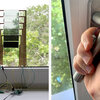Sommersemester 2021, BA/MA Produkt-Design
Canary – Revealing what's unseen
Canary allows any window to display hidden, but health-critical, information about outside air quality and ultra-violet indices.
Air pollution and exposure to ultraviolet sunlight kill millions of us every year. We aren’t satisfied that most people, even those actively concerned, can consistently keep track of air quality and UV indices, and thus are unable to make behavior changes to limit their exposure to these dangers; people still get sunburnt. Existing methods of keeping track of these indexes range from (yet another) smartphone notification to the instinctive and simple method of looking out the window (e.g. is it very sunny outside? Is the air quality so bad it affects visibility?). This method of looking out the window works well in extreme scenarios, but milder scenarios such as cloudy days can be deceiving, as well as failing to provide information about forecast changes.
But what if you could see more about UV and Air Quality indices and forecasts just by looking out the window? We explored different ways of visualizing and interacting with this data displayed on a window. We believe that over time this medium could become as instinctive as looking outside and seeing that it is raining. We also wanted you to really notice the system when it was important when the UV or air pollution levels are high enough that you need to reconsider your behavior and not overload you with information when action is not required.
Canary works by laying a film over a pre-existing window. The film is comprised of a grid of square LCD Blackout Panels that can each individually change from transparent to black based on electronic signals. These allow a simple forecast for the day to be animated and displayed on the window, with a higher index blocking more of the window and thus becoming very noticeable, and a low index barely interrupting the view. Power is provided by a solar panel on the exterior of the window.
The forecast is not displayed continuously, but the animation is triggered by walking past the window, or raising the blind, as part of a morning routine. Gesture sensors, or a knock sensor, can also be incorporated to trigger the animation manually as personally configured by the user.
A unique new interaction is also introduced through the window handle. If the user tries to open the window on days with dangerously bad air quality, currently or forecast, the handle will alert them to this danger through aggressive haptic feedback.
Canary is a project by Alasdair Grant, Johannes Schmidt, Xiaoyi Du & Zehan Bao.

Bitte Lizenz eintragen!
Keine Lizenz
Alle Rechte vorbehalten

Bitte Lizenz eintragen!
Keine Lizenz